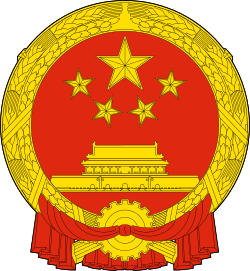Bhutan–China relations
 |
|
China |
Bhutan |
|---|---|
The Kingdom of Bhutan and the People's Republic of China do not maintain official diplomatic relations, and relations are historically tense.[1][2][3] The PRC shares a contiguous border of 470 kilometres (km) with Bhutan to the north and its territorial disputes with Bhutan have also been a source of potential conflict. Since the 1980s, the two governments have conducted regular talks on border and security issues aimed at reducing tensions.[1][2][3]
Background
Bhutan has long had strong cultural, historical, religious and economic connections to Tibet. Relations with Tibet were strained when Bhutan sided with the British Empire in its war with Tibet. Unlike Tibet, Bhutan had no history of being under the suzerainty of China, instead being under British suzerainty during the British Raj.
Bhutan's border with Tibet has never been officially recognised and demarcated. For a brief period, the Republic of China officially maintained a territorial claim on parts of Bhutan.[4] The territorial claim was maintained by the People's Republic of China after the Chinese Communist Party took control of mainland China in the Chinese Civil War. With the increase in soldiers on the Chinese side of the Sino-Bhutanese border after the 17-point agreement between the local Tibetan government and the central government of the PRC, Bhutan withdrew its representative from Lhasa.[4][5][6]
The 1959 Tibetan Rebellion and the 14th Dalai Lama's arrival in neighbouring ally India made the security of Bhutan's border with China a necessity for Bhutan. An estimated 6,000 Tibetans fled to Bhutan and were granted asylum, although Bhutan subsequently closed its border to China, fearing more refugees.[4][7]
Border issues

Along with the occupation of Tibet, the Chinese People's Liberation Army occupied eight western Tibetan enclaves under Bhutanese administration. A Chinese map published in 1961 showed China claiming territories in Bhutan, Nepal and the kingdom of Sikkim (now a state of India).[4] Incursions by Chinese soldiers and Tibetan herdsmen also provoked tensions in Bhutan. Imposing a cross-border trade embargo and closing the border, Bhutan established extensive military ties with India.[4][5][5] During the 1962 Sino-Indian War, Bhutanese authorities permitted Indian troop movements through Bhutanese territory.[4] However, India's defeat in the war raised concerns about India's ability to defend Bhutan. Consequently, while building its ties with India, Bhutan officially established a policy of neutrality.[2][4] According to official statements by the King of Bhutan to the National Assembly, there are four disputed areas between Bhutan and China. Starting from Doklam in the west, the border goes along the ridges from Gamochen to Batangla, Sinchela, and down to the Amo Chhu. The disputed area in Doklam covers 89 square kilometres (km2) and the disputed areas in Sinchulumpa and Gieu cover about 180 km2.[2]
Engagement
Until the 1970s, India represented Bhutan's concerns in talks with China over the broader Sino-Indian border conflicts.[2] Obtaining membership in the United Nations in 1971, Bhutan began to take a different course in its foreign policy.[8] In the U.N., Bhutan, incidentally alongside India, voted in favour of the PRC filling the seat occupied by the ROC and openly supported the "One China" policy.[2][3] In 1974 in a symbolic overture, Bhutan invited the Chinese ambassador to India to attend the coronation of Jigme Singye Wangchuk as the king of Bhutan.[2] In 1983, the Chinese Foreign Minister Wu Xueqian and Bhutanese Foreign Minister Dawa Tsering held talks on establishing bilateral relations in New York. In 1984, China and Bhutan began annual, direct talks over the border dispute.[2][5]
In 1998, China and Bhutan signed a bilateral agreement for maintaining peace on the border. In the agreement, China affirmed its respect for Bhutan's sovereignty and territorial integrity and both sides sought to build ties based on the Five Principles of Peaceful Co-existence.[2][3][5][9] However, China's building of roads on what Bhutan asserts to be Bhutanese territory, allegedly in violation of the 1998 agreement, has provoked tensions.[5][6][9] In 2002, however, China presented what it claimed to be 'evidence', asserting its ownership of disputed tracts of land; after negotiations, an interim agreement was reached.[2]
Recent Visit
On 11 August 2016 Bhutan Foreign Minister Damcho Dorji visited Beijing, capital of China, for the 24th round of boundary talks with Chinese Vice President Li Yuanchao. Both sides made comments to show their readiness to strengthen co-operations in various fields and hope of settling the boundary issues.[10]
See Also
References
- 1 2 A New Bhutan Calling (14 May 2008). OutlookIndia.com. Accessed 30 May 2008.
- 1 2 3 4 5 6 7 8 9 10 Bhutan-China relations (5 July 2004). BhutanNewsOnline.com. Accessed 30 May 2008.
- 1 2 3 4 India and the upcoming Druk democracy Archived 13 January 2008 at the Wayback Machine. (May 2007). HimalMag.com. Accessed 30 May 2008.
- 1 2 3 4 5 6 7 Bhutan - China relations Accessed 30 May 2008.
- 1 2 3 4 5 6 In Bhutan, China and India collide (12 January 2008). AsiaTimes.com. Accessed 30 May 2008.
- 1 2 Institute of Peace and Conflict Studies Archived 29 May 2008 at the Wayback Machine. (8 April 2008). IPCS.org. Accessed 30 May 2008.
- ↑ Bhutan: a land frozen in time (9 February 1998). BBC. Accessed 30 May 2008.
- ↑ Indo-Bhutanese relations. (1991) Library of Congress Country Studies Accessed 30 May 2008.
- 1 2 Bhutan Gazette (7 June 2007). BhutanGazette. Accessed 30 May 2008.
- ↑ "China hopes to forge diplomatic ties with Bhutan". Xinhua News. Retrieved 29 September 2016.

